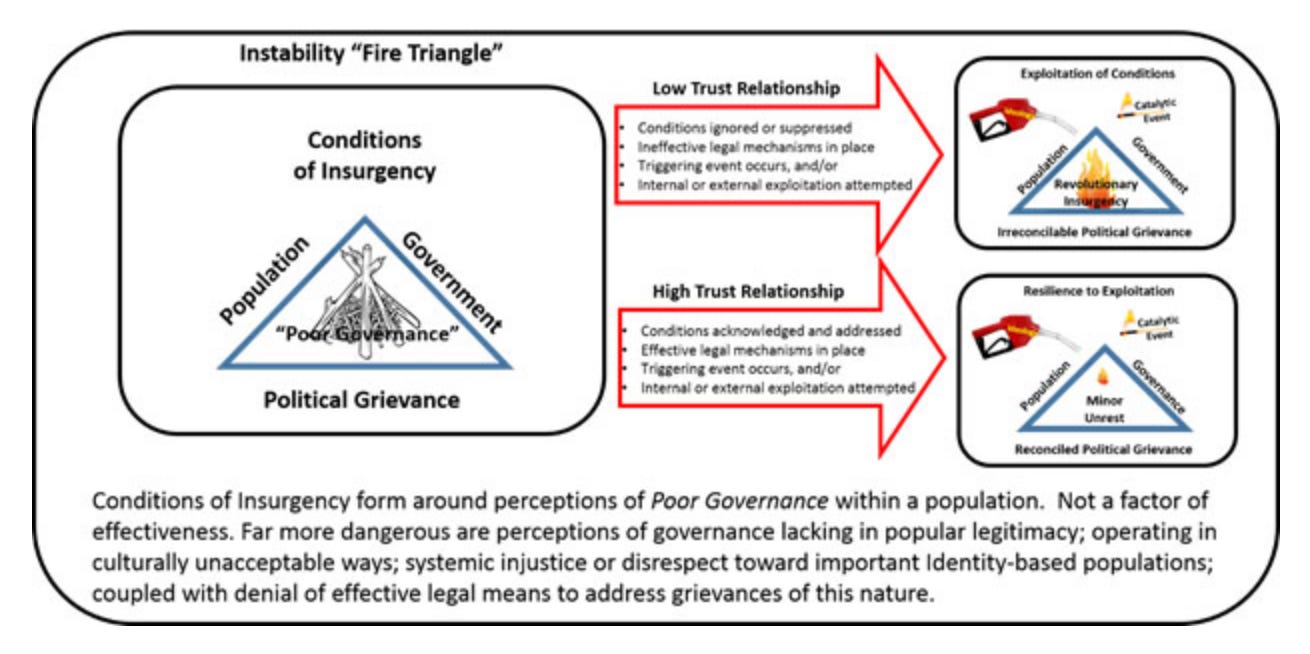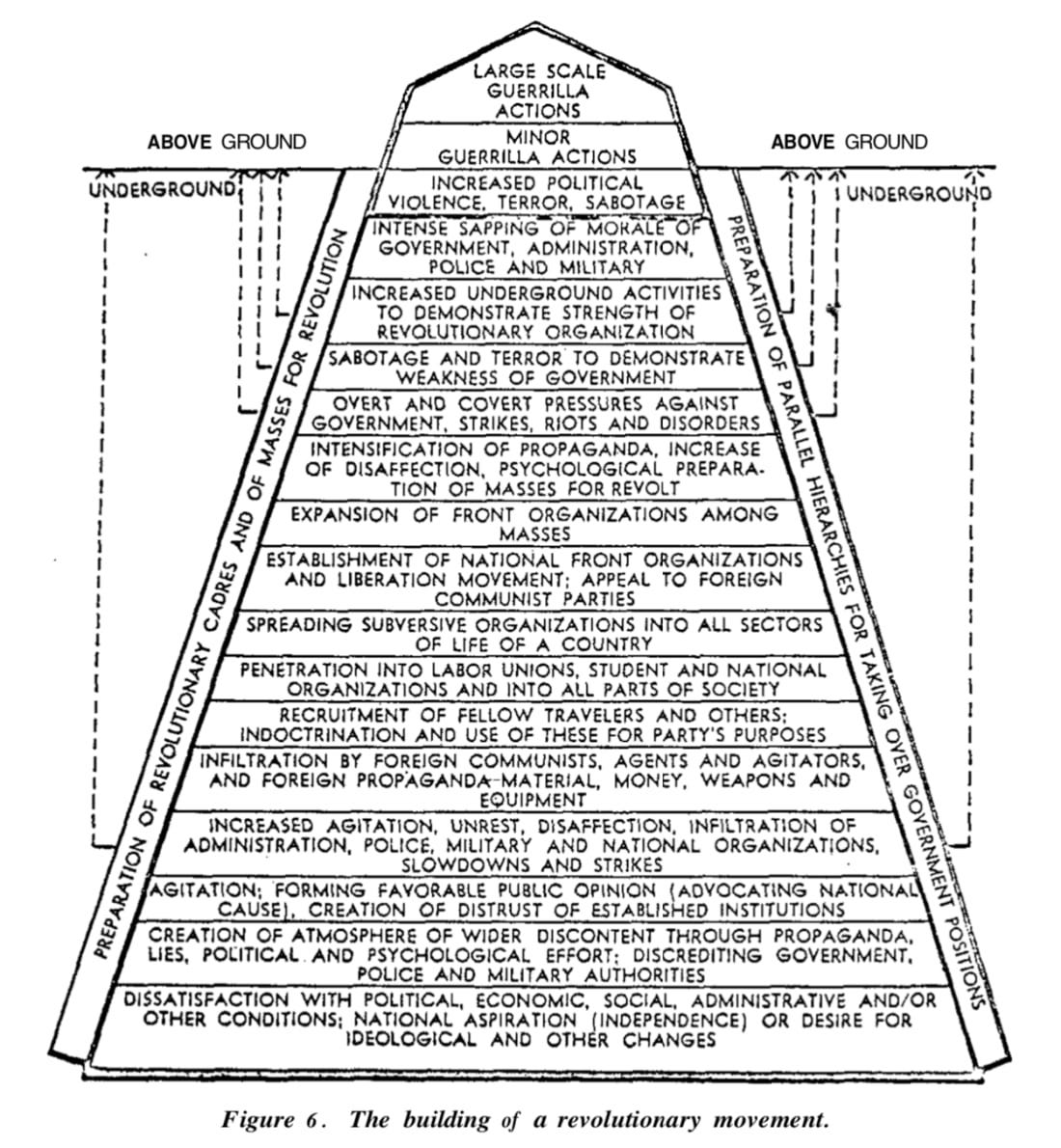I Don't Need Your Civil War: QMN069
Martial Mental Models: The Quartermaster Newsletter, Monday, 18 November
(This week’s report is a 6 minute read)
BLUF: What characterizes civil war - and why does it happen? Is there an underlying process going on? There are models to understand what’s happening in internal conflicts around the world - both to classify factors and understand the steps. By looking at civil conflict more as a process than an event, we can be smarter about how we approach the problem.
Brady here.Deadly protests against Chinese authorities in Hong Kong. Strikes and demonstrations driving down currency values in Chile. Drug cartels defeating the military in Mexico. There’s a lot going on in the world today that looks like civil war, or something very close to it. But our information is confusing: our news media covers it selectively and applies terms haphazardly. So what characterizes civil war -and why does it happen? And who benefits? Is there an underlying process going on when we think we see it? Green Berets are trained to operate within the conditions that lead to civil war - so lets look at what they learn. If you dig, you’ll see that civil war is one of many steps on a path to revolution - a step which sometimes is reached and other times skipped over.
These days, everything is civil war. We use the term to describe insurgencies, coups d’etat, and really any conflict that takes place within a country whether or not the people actually even take part. The term itself is an invention of Thomas Hobbes to describe the English Civil War in his book Leviathan - considered one of the most important texts in western politics. Here he described it as a war of “all against all” and made the case for strong, unified government as a way to avoid civil war. So to put some bounds on this thing, lets confine civil war to conflicts in which significant portion of the population actually takes part. A coup d’etat, where a military seizes control of the government from civilian authorities could, and often does, completely bypass the active involvement of the population.
In any context, civil war is often used to describe insurgency, where a people use armed violence to change their government. Good government provides a people with a way to resolve their differences or correct injustices internally, and when this capability is lost, you begin to see the conditions necessary for an insurgency. Probably the simplest way of examining the factors that lead to an insurgency, that I’ve seen, is the application of the “Fire Triangle” to civil conflict and insurgency. To build a fire, one needs three things: fuel, heat and oxygen - and in firefighting contexts, the thinking goes, that if you remove one of these necessities, you can put out the fire. In the insurgency application, the triangle is population, governance and grievance. An ineffective or distrusted government fails to provide a legal, controlled means to resolve legitimate grievances, and past a certain point, the people act outside of legal means and a fire starts. When this gets really bad, they seek to replace government with one that provides the order that’s needed. Additionally, I’d say, “sparks” that lead to a raging insurgency fire can include events that cause near-immediate and irrevocable outrage and get the fire going hot and fast - an example you’re familiar with would be the firing on Fort Sumter, which is regarded as the inflammatory event that started the American Civil War.

Image source: Small Wars Journal
In the image above, US Army Special Forces Colonel Robert C. Jones explains how a low-trust governance environment sets the conditions for insurgency. This has been the subject of study since the Second World War with the realization that in warfare, there are ways to speed up the combustion of civil war in your opponent's backyard. Civil wars create the right conditions for unconventional warfare - meaning that with civil war you typically get foreign intervention. As we’ve stated before here on The Quartermaster, there’s a step-by-step process to feed the insurgency fire toward civil war - and the one we described was developed by 20th century communist leaders and documented by the US Special Operations Research Office (SORO) - and what’s become the Assessing Revolutionary and Insurgent Strategies (ARIS) Studies project.

Just about any insurgency can be mapped along these steps. Image source: ARIS.
So where are real civil wars taking place today? Syria, for one.This conflict bleeds over into Iraq and Lebanon and is becoming more and more complex as more nations become actively involved. While extremely violent and shockingly lawless, the situation in Mexico is starting to look more like a failed state than anything - which often sets the stage for civil war but doesn’t guarantee it. What’s happening in South America currently are still violent protests and may not escalate to full-on armed conflict. When you read the news, just remember that there are a lot of factors involved and a lot of preconditions that situations must meet in order for it to be “all against all.”
Are we approaching civil war in the United States? Depends who you ask, and whether or not they’re trying to get clicks. It’s been pretty plain to see that there are growing divisions in American society - some will tell you it’s a matter of income inequality, others will tell you it’s racial, and still others will point to the differences between rural and urban Americans. The question is mostly one of trust in our systems - as Americans do we trust that our government, economy and the justice system we have provide fair and effective means of resolving conflicts - and do these allow citizens to provide for themselves? I’d say that civil war is a long way off for us, because our institutions are comparatively strong and resilient despite our growing differences in this nation. As James Mattis explained in his story this month, what we do today to maintain these institutions will likely answer this question for future generations. (BJM)
*****
VETERAN WISDOM: Make ‘Rules of Ranging’ Your Rules for Business: Part 6 (5 min) “When I was still a young infantryman and our military was fighting wars in both Afghanistan and Iraq, we were constantly told that “complacency kills.” Even though both of these warzones were very different from each other, these two words held true in both. In fact, they were just as true when my father was serving his tour in Vietnam and my grandfather was fighting in the Pacific theater during World War II. Don’t get comfortable just because things are going smoothly and according to plan.” (BJM)
A TOUGH BEAST TO TAME: Pentagon Progress in New Audit Undercut by Worsening Shortfalls (5 min) “But the Pentagon’s Inspector General, which oversaw the work, cited major shortcomings. For instance, while nearly 550 issues highlighted for correction last year were addressed this year, approximately 1,800 deficiency reports from last year were reissued, and an additional 1,300 were created. The inspector general also pointed out that there remain “insufficient policies, procedures, and internal controls for the acquisition, disposal, and inventory processes of government property in the possession of contractors.” (BJM)
DRIVEN BY MEANING: Christian Irvine: Thank you for the great honor of serving my country (4 min) “In November 2006, I was working a good job at a Fortune 50 company on the east coast. At the same time, my best friend from college, Chad, was a Marine in a sunny little spot known as Fallujah, Iraq. One fateful evening I was standing barefoot in the living room of my spacious, high-ceilinged, probably over-priced, apartment in the Ballentine area of Charlotte, N.C. I had just separated from the Air Force and was settling into the life I thought I was supposed to pursue. I was going to prove my work ethic and capability, and scratch, claw and elbow my way up to the top. And, unbeknownst to me, I was going to answer my phone and abandon all of it.” (BJM)
Remarks Complete. Nothing Follows.
KS Anthony (KSA) & Brady Moore (BJM)


